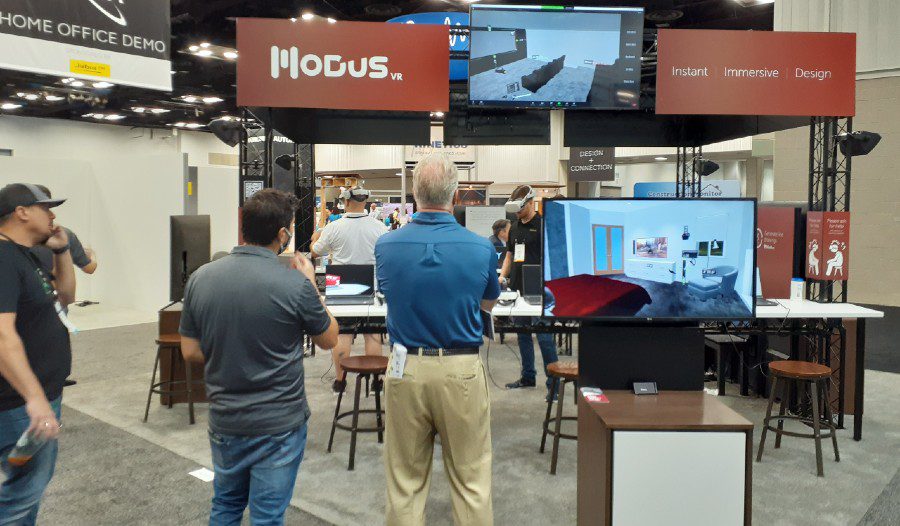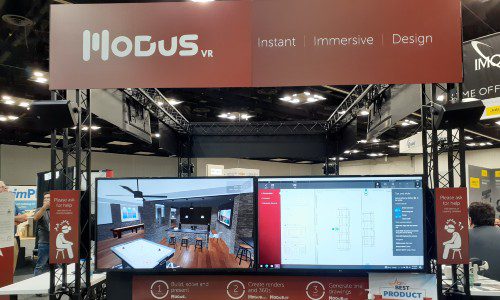It’s common practice for custom integrators to design and install the technology in their own showrooms; it makes for good beta testing, rack habits, calibration exercises and more. Following that mantra of practicing what you preach, Modus VR relied on a few team members to employ its unique virtual reality Modus 360 software to create its CEDIA Expo 2021 booth for the Sept. 1-3 event in Indianapolis.
Ken Brueck, co-founder of Modus VR, made note of that while at the Indiana Convention Center, and epitomizes the story that the award-winning company continues to share with attendees in its still relatively new experience as a CEDIA Expo participant.
The company’s dealers had a strong 2020 that Brueck mentioned during last year’s CEDIA Expo Virtual event, but he and Modus VR were happy to be back on a show floor where attendees could demo the product and see the upgrades.
“We had a 20×20 booth, which is smaller than what we’ve had in years past, and we had more to do than ever before. So we had to iterate on a lot of ideas,” he says of how the Modus team used its solution.
Brueck notes that a unique, headset VR-type of experience that Modus provides certainly works well for an in-person tradeshow or conference. The company’s CEDIA Expo booth incorporated signage that helped ensure along with Modus personnel, the attendees were demoing the system in as safe and cleanly a manner as possible.
“It’s a very experiential product, and so we want to do everything we can to have people try it out and see what it’s like, and also see what’s changed,” he says of the solution, which like other business software evolves based on important dealer feedback regarding functionalities.
Modus VR has witness the same growth of the industry into hybrid work spaces and work from home (WFH) opportunities; gaming rooms including golf simulation spaces; corporate conference spaces; and more in addition to its origins as a home theater design tool.
On the company website, integrators can check out an updated Modus posted in August prior to the CEDIA Expo that mentions: “This release brings a host of new objects suited for flushing out commercial spaces. From small details such as trash baskets and water coolers, all the way to large elements like glass wall partitions and office furniture; this release has much to offer in creating an authentic corporate environment.”
Brueck says indeed the company has used its pandemic time in a highly productive way to improve and bolster Modus VR’s 360 solution.
“Up until about 2019, 2020 our focus had been on virtual reality tools because there’s so much power there,” he explains. “But the pandemic accelerated our road map in such a way that we could start looking at these tools that happen outside of VR.”
Modus Photo, Modus Docs Integration Key
At the CEDIA Expo booth, he cited examples like Modus Photo, a tool that lets integrators generate high renderings and 360-degree images from projects build in Modus VR. The feature facilitates potential touchpoints for a dealer to optimize the customer experience during the entire project process.
“Since it’s so fast it lowers the barrier of entry for this experience to clients of any budget – you can do this for a $5,000 client,” he says. “No one’s been able to provide that before.”
Ken Brueck, co-founder, Modus VR
“It’s answering that question of, what is next after you’ve done that design session,” Brueck says. “That way, a rendering expert or photographer can come in, rapidly create these high-quality images and 360s in seconds that they can include in emails or proposals … really just complete that sale all the way through, keep momentum, keep the client excited.
“And also give the client something they can share with their friends and family,” he adds of the word-of-mouth (via today’s digital convenience) referral possibilities, which often accompany unique solutions – even if it’s a business tool like Modus VR’s.
Brueck also points out Modus Docs, which he describes as a “continually evolving tool,” that similar to Modus Photo ties into the proposal to generate key assets.
“Again, once you’ve built a project in Modus VR, you bring it into Modus Docs to generate line drawings and elevations,” he says. “And these are just as quick as everything else – our whole philosophy has always been built around speed.”

Integrators can very easily integrate specifics into the design and documentation process to give customers and even clearer vision of what their project entails. Oh, and they can impress the customer with their quick-turnaround capabilities and professionalism, Brueck adds.
“Once you’ve built a space, you can say, ‘All right, I want dimension lines here, here, here and here; you add your annotation and you’re good to go,” he says. “The client can go from having a VR design session in 30 minutes or so, make all sorts of decisions, and before they’re even home have in their inbox an email full of images, 360s and line drawings.”
Brueck says the prospects do not have to all be luxury clientele or small businesses with big budgets.
“Since it’s so fast it lowers the barrier of entry for this experience to clients of any budget – you can do this for a $5,000 client,” he says. “No one’s been able to provide that before.”







